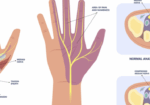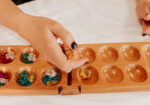Outcomes of Rigid Night Splinting and Activity Modification in the Treatment of Cubital Tunnel Syndrome
Filed under Treatments
Shah, C. M., Calfee, R. P., Gelberman, R. H., & Goldfarb, C. A. (2013). Outcomes of rigid night splinting and activity modification in the treatment of cubital tunnel syndrome (night splint for cubital tunnel syndrome). The Journal of Hand Surgery, 38(6), 1125–1130.e1. https://doi.org/10.1016/j.jhsa.2013.02.039
By: Sophia Grimm
The Skinny:
The purpose of this study was to identify symptom improvement in patients with mild to moderate cubital tunnel syndrome treated with rigid night orthosis and activity modifications. The degree of ulnar nerve dysfunction was identified according to Dellon’s classification.
- Dellon 1: Limited to intermittent paresthesia and weakness
- Dellon 2: Intermittent paresthesia and notable weakness
- Dellon 3 Persistent paresthesia and significant weakness with or without intrinsic muscular atrophy
Current conservative treatment guidelines for cubital tunnel syndrome are nerve gliding exercises, activity modification, and orthotic use. It is also common to use the cubital tunnel syndrome splint.
In the Weeds:
This study included 19 patients with Dellon’s 1 & 2 classification of cubital tunnel syndrome. All patients were treated with a rigid nighttime orthosis holding the elbow at a position of 45 degrees of flexion for 3 months and activity modifications to decrease irritation of the ulnar nerve. Patients were evaluated at enrollment, 6 weeks, 3 months, and 1 year with the QuickDASH, SF-12, grip and pinch strength measurement, presence or absence of Froment’s sign, and strength assessment of the first dorsal interosseous and flexor digitorum profundus to small finger. Researchers also used static 2-point discrimination of the 5th digit to assess for sensory changes, tinel’s at the elbow, evaluated ulnar nerve stability at the cubital tunnel, and assessed for a combined flexion with pressure provocation test by placing the patient’s elbow in maximum flexion and, while in this position, placing pressure on the ulnar nerve just proximal to the cubital tunnel. Electromyography and nerve conduction studies were also performed on all patients.
Bringing it Home:
The researchers found an 88% success rate for treating cubital tunnel syndrome in 21 out of 24 extremities with a rigid 45-degree nighttime orthosis and activity modifications. Both QuickDASH and SF-12 scores showed statistically and clinically significant improvement within 3 months of treatment. The improvements noted at 3 months were maintained at 1-year follow-up.

This study has promising clinical treatment findings for cubital tunnel syndrome. The sample size was small, and the study has not been replicated. All participants were treated with the same intervention and therefore no comparisons could be drawn. However, the subjective and objective data collected matched the findings of the study.
3 Comments
Leave a Comment
More To Read
A Review on the Conservative Management of Trigger Finger
Lunsford, D., Valdes, K., & Hengy, S. (2017). Conservative management of trigger finger: A systematic review. Journal of Hand Therapy, 32(2), 212-221. https://doi.org/10.1016/j.jht.2017.10.016 The Skinny The main purpose of the literature review was to determine the efficacy of conservative management of trigger finger (TF) through the use of an orthosis in addition to therapy. The review…
Read MoreCarpal Tunnel Release: Outcomes of Pediatric and Adolescent
Rapid Review. Outcomes of pediatric and adolescent carpal tunnel release based on etiology. Velicki, K., Goldfarb, C. A., Roberts, S., & Wall, L. B. (2021). Outcomes of pediatric and adolescent carpal tunnel release. The Journal of Hand Surgery, 46(3), 178-186. The Skinny: Less than 1% of pediatric carpal tunnel is idiopathic in nature, compared to…
Read MoreHow to Improve Fine Motor Translation Skills
By: Josh MacDonald The Basics – I lay a pile of small objects on the table and an open container for the client to put them into. What object I use depends on the client’s level. We’ll get to that later. Then, they use a 2-point pincer grasp to pick up one and shift it…
Read MoreEDS 101: Understanding Hypermobility in the Hand Therapy Setting
EDS in the Hand Therapy Setting General Overview:Ehlers Danlos Syndrome (EDS) is a group of heritable connective tissue disorders caused bygenetic changes that affect collagen production, the protein responsible for strength and elasticityin skin, ligaments and tendons (The Ehlers Danlos Society, 2016). There are thirteen forms of EDS that each have their own set of…
Read MoreSign-up to Get Updates Straight to Your Inbox!
Sign up with us and we will send you regular blog posts on everything hand therapy, notices every time we upload new videos and tutorials, along with handout, protocols, and other useful information.






Great article! Do you know why the splint is not positioned in full extension, why is it 45 degrees of flexion?
There is no mention of ulnar nerve gliding exercise (flossing) – is there are reason this was not included?
hello,
It was an article review focusing on orthosis fabrication therefore I don’t think it was a study objective of the authors
Miranda